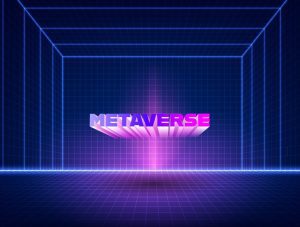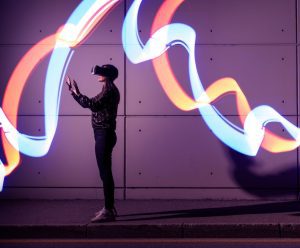You’ve probably heard the term “metaverse” buzzing around. It’s capturing the attention of individuals, businesses, and tech enthusiasts. One important aspect of the metaverse is the Spatial Metaverse, a concept that brings a 3D network of virtual worlds to life, creating a space where people can connect using augmented reality (AR) and virtual reality (VR) technologies.
What Is The Spatial Metaverse ?

So, what does Spatial Metaverse mean? Well, it’s a game-changer in how we see and interact with the digital world. Unlike the flat, two-dimensional online spaces we’re used to, Spatial Metaverse takes things up a notch. You explore, collaborate, and engage with others in a virtual space that feels real.
At its core, the Spatial Metaverse is about blending the digital and physical worlds. It builds a shared space that goes beyond geographical borders, allowing people to connect, work together, and explore together.
The term “spatial” in Spatial Metaverse emphasizes the importance of space and environment, highlighting the immersive nature of the virtual worlds within this interconnected network.
One standout player in this game is Spatial.io, a platform on a mission to empower creators and brands to build their own spaces in the metaverse. This isn’t just about creating cool 3D spaces; it’s about sharing culture, content, and building a community.
When you dive into Spatial.io, you get to create your own avatar – a digital version of yourself in this virtual world. These avatars aren’t just pixelated figures; they look and feel real, adding a touch of authenticity to your virtual interactions. And guess what? You can customize them to express your style and identity.
As you use Spatial.io, you’ll realize that the Spatial Metaverse is not a one-size-fits-all kind of deal. It’s a collection of individually crafted spaces that come together to form a larger interconnected universe.
The platform allows you to choose and personalize your own space, making it uniquely yours. This emphasis on personalization reinforces the idea that the Spatial Metaverse is a diverse and dynamic collection of individual expressions contributing to a larger, interconnected whole. But how does it all work? Well, Spatial.io’s user-friendly interface makes it a breeze.
You can integrate tools you’re already familiar with, like Microsoft Office, MetaMask Wallet, and Google Drive, making your virtual space as functional as your physical one. This integration is like a bridge between the real and virtual worlds, making the transition into the Spatial Metaverse smooth and accessible.
However, the real magic of the Spatial Metaverse lies in community building. It’s not just about exploring spaces on your own; it’s about connecting with others.
Through the exploration tab, you can discover spaces and avatars created by fellow members of the Spatial community. This adds a social layer to the experience, turning it into a place where people can meet, collaborate, and share experiences.
And it doesn’t stop there. The Spatial Metaverse is all about inviting others to join your virtual workspace. By sharing invite links, you can expand your digital presence and create shared experiences with friends, colleagues, or collaborators.
This collaborative aspect enhances the social fabric of the Spatial Metaverse, turning it into a space where people can gather, interact, and engage in various activities together.
So the spatial metaverse is a game-changer in how we interact online and experience digital spaces. It represents a vision where the lines between the physical and digital worlds blur, giving rise to a new era of immersive, interconnected experiences.
Platforms like Spatial.io serve as gateways to this evolving metaverse, offering users the tools and experiences to shape their virtual presence and contribute to the interconnected tapestry of the Spatial Metaverse.
See Also: What Is Google Metaverse : 4 Important Advantages Of Google Metaverse
7 Features Of The Spatial Metaverse

Let’s discover the fantastic capabilities that platforms like Spatial.io bring to the table.
1. Events In The Spatial Metaverse
Let’s kick off with something exciting – events! In the Spatial Metaverse. Platforms like Spatial make it super easy to create and enjoy events in your virtual space.
Whether it’s a virtual meetup with friends, a conference, or a creative showcase, these event creation tools make it a breeze to organize memorable experiences.
Imagine having an “Empty Frame” where you can upload pictures or videos anytime you want. It’s like having your personal space to share things you love.
Then there’s the “Project Surface,” a special spot for screen sharing, making presentations a piece of cake. And don’t forget the “Host Tools” – they help you manage and moderate your virtual world, ensuring everything runs smoothly during your event.
Why does this matter? Well, it’s all about making virtual events more than just online gatherings. These tools add a touch of magic, making them immersive experiences that stick with you.
2. Building Worlds with Spaces and Space Templates
Now, let’s talk about building your own virtual world. Spatial.io introduces this cool concept called Spaces and Space Templates. A “Space” is like a ready-to-go world you can use right away. But here’s the fun part – “Space Templates” let you create multiple spaces from one template without leaving the platform.
Why is this a big deal? It gives you the power to design your virtual environment. You can choose themes, make it cozy or futuristic – the possibilities are endless. Creating a new template from an existing space? That’s like a shortcut to building your dream world. It’s all about making the Spatial Metaverse diverse and creative.
3. Custom Avatars in the Spatial Metaverse
Now, let’s talk about avatars – your digital self in the Spatial Metaverse. Spatial.io takes avatar customization to a whole new level by teaming up with Ready Player Me. This partnership lets you use your avatars across different platforms, keeping your digital identity consistent.
But wait, there’s more! You can also create and upload your own avatars into your virtual worlds. These avatars come in two types – World Avatars for your personal world and Universal Avatars that work in any Spatial space. Even though there are some limits, like the number of polygons and textures, these avatars give you loads of options to express yourself.
4. Game On with Quests and Rewards
Now, let’s add some gaming fun to the mix. Spatial.io’s latest updates bring quests and rewards into the picture. What are quests? They’re like a series of fun tasks that lead you to specific goals. You could be discovering treasures or facing challenges. Along the way, you earn rewards in the form of badges that show up on your profile. Why throw in quests and rewards? It’s all about making your time in the Spatial Metaverse exciting and rewarding.
5. Drivable Vehicles in the Spatial Metaverse
Now, here’s something cool – drivable vehicles! Spatial.io introduces this new feature where creators can upload 3D vehicles, even ones with four wheels.
These vehicles use Unity’s physics, making your experiences in the Spatial Metaverse more realistic. Imagine having races, tours, or explorations with your friends in unique vehicles.
Why is this a game-changer? It takes your virtual adventures up a notch, giving you more ways to have fun and interact with others.
6. Easy Scripting with Unity: Unleash Your Creativity
Let’s talk tech, but in simple terms. Spatial introduces visual scripting with Unity. It might not be the full version of Unity, but it’s like a simplified version that lets you create your actions. You can do things like changing avatars and adding cool customizations to your virtual world.
What does this mean for you? It’s like having your creative toolbox. You might not be a tech genius, but with over 15,000 nodes from Unity, you get plenty of options to make your virtual world uniquely yours.
7. The Economy Function in Spatial Metaverse
Now, let’s look into something important – money! Spatial.io recently added an “economy” function. This means you can make money with your creations. Worlds in the Spatial Metaverse become ecosystems where you can sell and buy items using a specific currency.
Spatial metaverse turns your virtual world into a marketplace. You can sell or rent your creations, making your efforts in the Spatial Metaverse not just creative but also rewarding.
Spatial.io gives you a virtual playground where you can create, explore, and have a blast. Whether it’s crafting events, building worlds, or adding cool features like quests and drivable vehicles, Spatial.io makes the Spatial Metaverse your own creative space.
The platform’s partnership with Unity, along with visual scripting and the added economy function, shows that Spatial.io is serious about making you the boss of your virtual world. As technology keeps moving forward, the Spatial Metaverse is ready to redefine how we connect, create, and have fun online.
See Also: What is Metaverse Marketing and 10 Best Steps For Metaverse Marketing
The Magic of Spatial’s Metaverse Adventure with Unity

Let’s take a stroll through Spatial’s evolution, with a special focus on how it joined forces with Unity, a giant in the world of game development engines.
In this subheading we’ll look at how Spatial is shaping the Spatial Metaverse, offering users a virtual experience that’s not only robust but also filled with creative possibilities.
Unity Steps into Spatial’s World: A Game-Changing Collaboration
One important moment in Spatial’s journey was its integration with Unity, a leading game development engine. Unity’s stellar reputation in the gaming industry brought a world of possibilities to Spatial.io, allowing users to tap into the power of Unity for crafting and customizing their virtual worlds.
This integration marked a significant shift in Spatial’s capabilities. Users could now leverage Unity’s extensive features to elevate their virtual spaces, from creating intricate designs to implementing interactive elements. The collaboration with Unity opened doors to a vast array of tools and resources, empowering users to take their metaverse experiences to new heights.
A Harmonious Blend of Technologies
The partnership between Spatial and Unity goes beyond a mere integration. It’s a harmonious blend of technologies that enhances the overall metaverse experience. Users familiar with Unity found themselves on familiar ground, making the transition to Spatial.io smoother and more intuitive.
Spatial’s decision to integrate with Unity was strategic, recognizing the widespread use and popularity of Unity within the developer community. This partnership not only brought Unity’s powerful game development capabilities to Spatial users but also created a bridge between two thriving ecosystems.
As a result, Spatial users could tap into Unity’s extensive library of assets, plugins, and development tools to enrich their metaverse creations.
Unity’s Role in Spatial’s Versatility
When it comes to world creation within the Spatial Metaverse, Unity’s influence is unmistakable. Spatial.io users gained access to Unity’s Content Creator Toolkit, a set of tools designed to simplify the process of building immersive virtual environments.
This toolkit became the cornerstone for Spatial’s versatility, allowing users to craft worlds tailored to their specific needs and preferences.
Unity’s role in world creation extended to the introduction of Spaces and Space Templates within Spatial.io Users could now design custom spaces using Unity and leverage templates for reusability. This flexibility added a layer of efficiency to the creative process, enabling users to build diverse virtual landscapes without starting from scratch.
Spatial’s Customization Beyond The Basics
As Spatial evolved, it introduced visual scripting with Unity, providing users with a way to add custom functionality to their worlds. While this visual scripting may be a limited version compared to the full Unity framework, it opened up a realm of possibilities for users to create their own actions and interactions within their virtual spaces.
This addition meant that users could go beyond the basics offered by the Spatial Content Creator. Visual scripting with Unity allowed the creation of unique experiences, from avatar exchanges to custom interactions. While there were some limitations compared to the full Unity version, the vast array of nodes and pre-implemented functionalities provided users with ample room for customization.
Unity’s Toolkit in Spatial’s Economic Landscape: Monetizing Creativity
A noteworthy aspect of Spatial’s evolution in conjunction with Unity is the introduction of the “economy” function. This function, designed to monetize creations made with the Creator Toolkit, seamlessly integrates with Unity’s toolkit. Creators within the Spatial Metaverse can now leverage Unity’s features to monetize their creative endeavors.
The collaboration between Spatial.io and Unity in the realm of the economy function extends to items and monetization strategies. Unity’s influence can be seen in the association of items with specific worlds and the distinct scopes they possess. This integration adds depth to the virtual economy, allowing creators to sell and distribute items within their worlds.
Spatial’s journey, marked by its integration with Unity, reflects a commitment to providing users with a comprehensive and versatile metaverse experience. The impact of this partnership is evident in every aspect, from world creation to customization and monetization.
As the Spatial Metaverse continues to evolve, the collaboration between Spatial and Unity stands as a testament to the transformative potential of strategic partnerships in shaping the future of virtual interactions.
See Also: The Green Metaverse Token That Pays You to Exercise in 2024
Conclusion

We’ve looked at the journey of Spatial.io, a platform that’s reshaping virtual experiences. Partnering with Unity, Spatial opened doors to creative wonders, letting users craft unique worlds effortlessly. The integration allowed seamless transitions for Unity enthusiasts, propelling the metaverse into new realms.
Spatial’s evolution is marked by user-friendly tools, from Content Creator Toolkit to visual scripting with Unity. Unity’s impact on world creation, customization, and economic functions within Spatial is evident, adding layers to the metaverse’s richness. The duo’s collaboration birthed a harmonious blend, creating immersive landscapes that captivate users.
As we ponder the future, Spatial and Unity stand as pioneers, steering the metaverse toward innovation. The commitment to user empowerment and creative freedom underscores Spatial’s journey.
Together, they’ve not just shaped a platform but sculpted an immersive, dynamic metaverse that resonates with creators and users alike.
We Hope you’ve learned a lot from this article!! We’re glad you did. Join our telegram community to get up-to-date news, educational materials, free online classes, market analysis, and crypto futures trade signals that will help you grow and become profitable